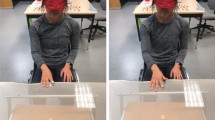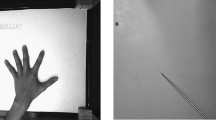Abstract
Perceiving the external spatial location of the limbs using position sense requires that immediate proprioceptive afferent signals be combined with a stored body model specifying the size and shape of the body. Longo and Haggard (Proc Natl Acad Sci USA 107:11727–11732, 2010) developed a method to isolate and measure this body model in the case of the hand in which participants judge the perceived location in external space of several landmarks on their occluded hand. The spatial layout of judgments of different landmarks is used to construct implicit hand maps, which can then be compared with actual hand shape. Studies using this paradigm have revealed that the body model of the hand is massively distorted, in a highly stereotyped way across individuals, with large underestimation of finger length and overestimation of hand width. Previous studies using this paradigm have allowed participants to see the locations of their judgments on the occluding board. Several previous studies have demonstrated that immediate vision, even when wholly non-informative, can alter processing of somatosensory signals and alter the reference frame in which they are localised. The present study therefore investigated whether immediate vision contributes to the distortions of implicit hand maps described previously. Participants judged the external spatial location of the tips and knuckles of their occluded left hand either while being able to see where they were pointing (as in previous studies) or while blindfolded. The characteristic distortions of implicit hand maps reported previously were clearly apparent in both conditions, demonstrating that the distortions are not an artefact of immediate vision. However, there were significant differences in the magnitude of distortions in the two conditions, suggesting that vision may modulate representations of body size and shape, even when entirely non-informative.



Similar content being viewed by others
References
Abramoff MD, Magelhaes PJ, Ram SJ (2004) Image processing with Image. J Biophotonics Intern 11:36–42
Bookstein FL (1991) Morphometric tools for landmark data. Cambridge University Press, Cambridge
Calford MB, Tweedale R (1991) C-fibres provide a source of masking inhibition to primary somatosensory cortex. Proc R Soc B 243:269–275
Cardini F, Longo MR, Haggard P (2011) Vision of the body modulates somatosensory intracortial inhibition. Cereb Cortex 21:2014–2022
Darling WG, Miller GF (1993) Transformations between visual and kinaesthetic coordinate systems in reaches to remembered object locations and orientations. Exp Brain Res 93:534–547
Facchini S, Aglioti SM (2003) Short term light deprivation increases tactile spatial acuity in humans. Neurology 60:1998–1999
Ferrè ER, Vagnoni E, Haggard P (2013) Vestibular contributions to bodily awareness. Neuropsychologia 51:1445–1452
Fiehler K, Rösler F, Henriques DY (2010) Interaction between gaze and visual and proprioceptive position judgments. Exp Brain Res 203:485–498
Forster B, Eimer M (2005) Vision and gaze direction modulate tactile processing in somatosensory cortex: evidence from event-related brain potentials. Exp Brain Res 165:8–18
Gandevia SC, Phegan CM (1999) Perceptual distortions of the human body image produces by local anesthesia, pain and cutaneous stimulation. J Physiol 514:609–616
Haggard P, Iannetti GD, Longo MR (2013) Spatial sensory organization and body representation in pain perception. Curr Biol 23:R164–R176
Harrar V, Harris LR (2009) Eye position affects the perceived position of touch. Exp Brain Res 198:403–410
Harrar V, Harris LR (2010) Touch used to guide action is partially coded in a visual reference frame. Exp Brain Res 203:615–620
Jones SA, Henriques DY (2010) Memory for proprioceptive and multisensory targets is partially coded relative to gaze. Neuropsychologia 48:3782–3792
Kennett S, Taylor-Clarke M, Haggard P (2001) Noninformative vision improves the spatial resolution of touch in humans. Curr Biol 11:1188–1191
Longo MR, Haggard P (2010) An implicit body representation underlying human position sense. Proc Natl Acad Sci USA 107:11727–11732
Longo MR, Haggard P (2012a) A 2.5-D representation of the human hand. J Exp Psychol Human Percept Perform 38:9–13
Longo MR, Haggard P (2012b) Implicit body representations and the conscious body image. Acta Psychol 141:164–168
Longo MR, Sadibolova R (2013) Seeing the body distorts tactile size perception. Cognition 126:475–481
Longo MR, Betti V, Aglioti SM, Haggard P (2009) Visually induced analgesia: seeing the body reduces acute pain. J Neurosci 29:12125–12130
Longo MR, Azañón E, Haggard P (2010) More than skin deep: body representation beyond primary somatosensory cortex. Neuropsychologia 48:655–668
Longo MR, Long C, Haggard P (2012) Mapping the invisible hand: a body model of a phantom limb. Psychol Sci 23:740–742
Lopez C, Schreyer H-M, Preuss N, Mast FW (2012) Vestibular stimulation modifies the body schema. Neuropsychologia 50:1830–1837
Mancini F, Longo MR, Kammers MPM, Haggard P (2011) Visual distortion of body size modulate pain perception. Psychol Sci 22:325–330
Moseley GL (2005) Distorted body image in complex regional pain syndrome. Neurology 65:773
Napier J (1980) Hands. Princeton University Press, Princeton
Pelz E, Seifert F, Lanz S, Müller R, Maihöfner C (2011) Impaired hand size estimation in CRPS. J Pain 12:1095–1101
Pritchett LM, Harris LR (2011) Perceived touch location is coded using a gaze signal. Exp Brain Res 213:229–234
Proske U, Gandevia SC (2012) The proprioceptive senses: their roles in signalling body shape, body position and movement, and muscle force. Physiol Revs 92:1651–1697
Rholf FJ, Slice DE (1990) Extensions of the Procrustes method for the optimal superimposition of landmarks. Syst Zool 39:40–59
Schwenkreis P, Janssen F, Rommel O, Pleger B, Völker B, Hosbach I, Dertwinkel R, Maier C, Tegenthoff M (2003) Bilateral motor cortex disinhibition in complex regional pain syndrome (CRPS) type I of the hand. Neurology 61:515–519
Weisser V, Stilla R, Peltier S, Hu X, Sathian K (2005) Short-term visual deprivation alters neural processing of tactile form. Exp Brain Res 166:572–582
Wong M, Hackeman E, Hurd C, Goldreich D (2011) Short-term visual deprivation does not enhance passive tactile spatial acuity. PLoS ONE 6:e25277
Zubek JP, Flye J, Aftanas M (1964) Cutaneous sensitivity after prolonged visual deprivation. Science 144:1591–1593
Acknowledgments
This research was supported by a grant from the European Research Council (ERC-2013-StG-336050) to MRL.
Author information
Authors and Affiliations
Corresponding author
Rights and permissions
About this article
Cite this article
Longo, M.R. The effects of immediate vision on implicit hand maps. Exp Brain Res 232, 1241–1247 (2014). https://doi.org/10.1007/s00221-014-3840-1
Received:
Accepted:
Published:
Issue Date:
DOI: https://doi.org/10.1007/s00221-014-3840-1




